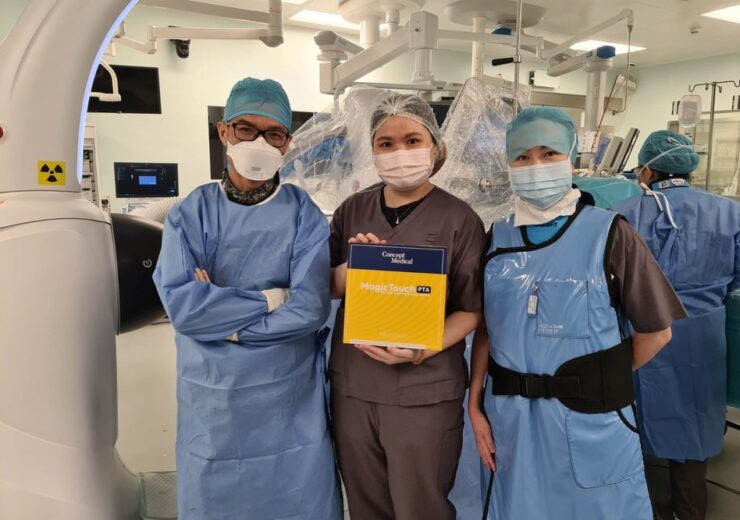The study will evaluate MagicTouch PTA sirolimus drug coated balloon compared to standard percutaneous transluminal angioplasty

First patient enrolled in the FUTURE SFA at Sengkang General Hospital. (Credit: Concept Medical Inc.)
Concept Medical has enrolled the first patient in randomised controlled trial of first sirolimus coated balloon versus standard balloon angioplasty in the treatment of superficial femoral artery and popliteal artery disease (FUTURE SFA).
FUTURE SFA is aimed at evaluating performance of MagicTouch PTA sirolimus drug coated balloon compared to standard percutaneous transluminal angioplasty for the treatment of superficial femoral and popliteal arterial disease.
Edward Choke, an associate professor from the department of general surgery at the Sengkang General Hospital, Singapore, is serving as the principal investigator of FUTURE-SFA.
Edward Choke said: “I am inspired by the bold, imaginative and futuristic concepts presented by the Nanolute technology of the MagicTouch PTA sirolimus coated balloon. In contrast to other contemporary technologies, MagicTouch PTA offers a solution which optimizes both the deliverability and the absorption of sirolimus into the vessel wall.”
MagicTouch PTA sirolimus coated balloon (SCB) is an advanced transcatheter technology
According to the company, current standard of care for severe peripheral arterial disease (PAD) is revascularisation, where balloon angioplasty is predominantly used to unblock the vessel and restore blood flow to the leg.
Despite the revascularisation procedures using balloon angioplasty, the blood vessels often get repeatedly blocked, leading to procedures that may be dangerous or result in loss of limb or even life.
The company said that its MagicTouch PTA sirolimus coated balloon (SCB) is an advanced transcatheter technology to prevent restenosis for diseased arteries.
The clinical trial is designed to enrol 153 Rutherford class 3 to 6 PAD patients, who will be randomised in 2:1 ratio to receive treatment using Magic Touch PTA or standard balloon angioplasty. The participants in the study will be followed up for two years.
FUTURE SFA is planned to follow a severe blinding protocol to minimise bias, where patients, care providers, investigators and outcome assessors, including vascular technologists, will be blinded to the treatment allocations.
Choke added: “Initial experience with the XTOSI first in man study suggested that MagicTouch PTA can provide an effective way of revascularization for PAD patients, by keeping the vessels open longer and reducing the need of repeated angioplasty procedures.
“I look forward to the FUTURE-SFA randomized controlled trial, which will test whether the Magic Touch PTA sirolimus coated balloon can improve the patencies of femoral and popliteal arteries in PAD patients. We hope to establish whether SCB will emerge as the new standard of care which will impact the way we treat PAD.”
